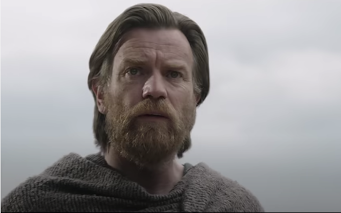
By Uy Pham
Writer’s note: This article contains spoilers for the “Obi-Wan Kenobi” series.
Streaming on Disney+ starting late May, Lucasfilm’s “Obi-Wan Kenobi” lets viewers embark on a six-episode journey about Obi-Wan Kenobi’s life between Episode 3: Revenge of the Sith and Episode 4: A New Hope of the Star Wars trilogies. With fans having high expectations upon this series’ release, director Deborah Chow definitely created a continuation of Obi-Wan Kenobi’s journey which surpassed expectations throughout the progression of the series.
Obi-Wan Kenobi, played by Ewan McGregor, who reprises his role as the character from the Star Wars prequel trilogy, lives a quiet, repetitive life in isolation in a cave on Tatooine while he tries to reconcile with his failure of losing Anakin Skywalker in the infamous Battle of Mustafa. He distances himself from Jedi and Force-sensitive supporters on the planet.
The series introduces Reva Sevander, an ambitious Inquisitor named the Third Sister. The Inquisitors are agents tasked with hunting down supporters of the Force. Backed by the support of Darth Vader, Reva pursues her goal to hunt down Obi-Wan Kenobi.
However, Obi-Wan comes out of self-isolation when his friend Bail Organa pleads with Obi-Wan to commence a rescue mission for his daughter, a young Leia Organa who was kidnapped by mercenaries working for Reva. Leia’s playful, energetic and cautious character presents a challenge for Obi-Wan to ensure her safe return from captivity to home in Alderaan.
Obi-Wan Kenobi is one of my favorite characters from the prequel trilogy of the Star Wars universe due to his status and influence as a Jedi Master. With the announcement of this series, I wanted to watch this expansion of Obi-Wan’s story. Despite knowing the main characters Darth Vader, Obi-Wan and Leia would survive the series, director Chow presents a dramatic and tense storyline with several twists and turns.
One of my favorite aspects of this series is the progression of several characters and their increasingly significant impacts on the story. Haja Estree, an impostor Jedi on Daiyu who offers assistance in exchange for money, becomes a caring guardian for Leia while Obi-Wan Kenobi leaves to defend others. Reva turns out to have strong emotional connections to the execution of Order 66 and greater intentions than capturing Obi-Wan. Leia initially refuses to trust Obi-Wan’s efforts to save her; however, in the last episode, Leia is extremely thankful for Obi-Wan’s heroic journey, which strengthens the bond between the two characters.
The continuous development of characters throughout the series was extremely intriguing and accompanied my viewing of the main plotline, Obi-Wan’s mission to rescue Leia.
Several references from this series to other episodes in the Star Wars franchise create a captivating viewing experience for me to revisit some of the most notable moments in this universe.
In Episode 5 of Obi-Wan Kenobi, Hayden Christensen returns to play Anakin Skywalker in flashbacks of a training duel between him and Obi-Wan. I was ecstatic for both Christensen’s return and how closely these flashbacks resemble the actions and dialogue of the infamous Battle of Mustafa in Revenge of the Sith.
Furthermore, in the final episode, while dueling Obi-Wan, Darth Vader coldly cackles, “You didn’t kill Anakin Skywalker. I did,” referencing how, in A New Hope, Obi-Wan tells Luke Skywalker that Darth Vader killed Luke’s father. I loved this reference to the short, but crucial line in the first movie ever released in this franchise.
The continuous humor of the Galactic Empire’s incompetent defense of their territory brought laughable moments and an overall humorous watching experience when I witnessed extremely questionable actions by the Empire.
For example, in Episode 2, it was stunning to watch Stormtroopers fail to realize the man they are trying to hunt, Obi-Wan, is sitting directly in front of them in a truck ride. All Obi-Wan needs is to throw a hood over his attire and lie about his background to the Stormtroopers.
Additionally in Episode 4, I found it hilarious how Obi-Wan Kenobi, the most wanted man by the Empire, sneaks onto an Empire fortress on Nur and successfully escapes without being detected by security systems or the countless Stormtroopers and officers patrolling the base. He is only recognized until after the damage is done. Better yet, he still escapes after he is detected due to the well-known, horrendous aim of the Stormtroopers.
I could not stop shaking my head and laughing while watching the failures of the Empire; truly, the Galactic Empire’s army is no match for the strength and skill of Obi-Wan’s utilization of the Force.
In the last episode, the ultimate duel between Obi-Wan and Darth Vader was one of the best scenes in this entire series. I loved watching Obi-Wan return to his skilled self and intensely challenge Darth Vader’s ability. This presented Obi-Wan’s development throughout the series by providing a firm contrast to Obi-Wan’s struggles to put up a fight against Darth Vader in Episode 3 after many years in hiding. The cinematography of this duel crafted a satisfying final episode for this series.
Although the series contains hilarious moments and questionable plot events, “Obi-Wan Kenobi” is a must-watch if you are interested in the continued story of Obi-Wan Kenobi and the Star Wars franchise, the development of Obi-Wan’s bond with Leia, and the references to other Star Wars trilogies. With rumors of a second season, I am definitely interested in how the story of Obi-Wan will continue.





